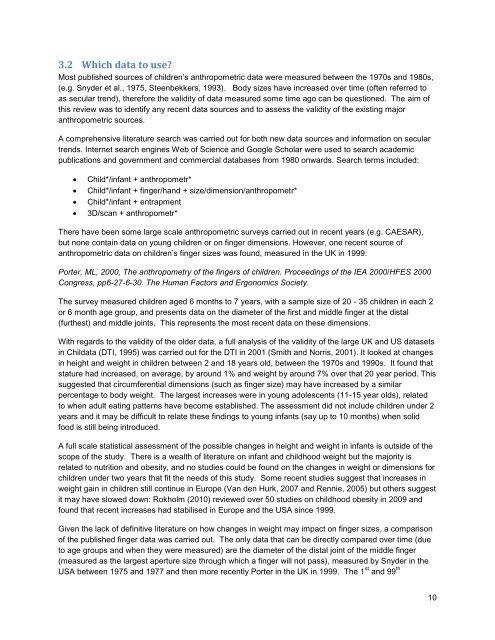Requirements for finger entrapment in European safety ... - ANEC
Requirements for finger entrapment in European safety ... - ANEC
Requirements for finger entrapment in European safety ... - ANEC
You also want an ePaper? Increase the reach of your titles
YUMPU automatically turns print PDFs into web optimized ePapers that Google loves.
3.2 Which data to use?<br />
Most published sources of children’s anthropometric data were measured between the 1970s and 1980s,<br />
(e.g. Snyder et al., 1975, Steenbekkers, 1993). Body sizes have <strong>in</strong>creased over time (often referred to<br />
as secular trend), there<strong>for</strong>e the validity of data measured some time ago can be questioned. The aim of<br />
this review was to identify any recent data sources and to assess the validity of the exist<strong>in</strong>g major<br />
anthropometric sources.<br />
A comprehensive literature search was carried out <strong>for</strong> both new data sources and <strong>in</strong><strong>for</strong>mation on secular<br />
trends. Internet search eng<strong>in</strong>es Web of Science and Google Scholar were used to search academic<br />
publications and government and commercial databases from 1980 onwards. Search terms <strong>in</strong>cluded:<br />
<br />
<br />
<br />
<br />
Child*/<strong>in</strong>fant + anthropometr*<br />
Child*/<strong>in</strong>fant + <strong>f<strong>in</strong>ger</strong>/hand + size/dimension/anthropometr*<br />
Child*/<strong>in</strong>fant + <strong>entrapment</strong><br />
3D/scan + anthropometr*<br />
There have been some large scale anthropometric surveys carried out <strong>in</strong> recent years (e.g. CAESAR),<br />
but none conta<strong>in</strong> data on young children or on <strong>f<strong>in</strong>ger</strong> dimensions. However, one recent source of<br />
anthropometric data on children’s <strong>f<strong>in</strong>ger</strong> sizes was found, measured <strong>in</strong> the UK <strong>in</strong> 1999:<br />
Porter, ML, 2000, The anthropometry of the <strong>f<strong>in</strong>ger</strong>s of children. Proceed<strong>in</strong>gs of the IEA 2000/HFES 2000<br />
Congress, pp6-27-6-30. The Human Factors and Ergonomics Society.<br />
The survey measured children aged 6 months to 7 years, with a sample size of 20 - 35 children <strong>in</strong> each 2<br />
or 6 month age group, and presents data on the diameter of the first and middle <strong>f<strong>in</strong>ger</strong> at the distal<br />
(furthest) and middle jo<strong>in</strong>ts. This represents the most recent data on these dimensions.<br />
With regards to the validity of the older data, a full analysis of the validity of the large UK and US datasets<br />
<strong>in</strong> Childata (DTI, 1995) was carried out <strong>for</strong> the DTI <strong>in</strong> 2001 (Smith and Norris, 2001). It looked at changes<br />
<strong>in</strong> height and weight <strong>in</strong> children between 2 and 18 years old, between the 1970s and 1990s. It found that<br />
stature had <strong>in</strong>creased, on average, by around 1% and weight by around 7% over that 20 year period. This<br />
suggested that circumferential dimensions (such as <strong>f<strong>in</strong>ger</strong> size) may have <strong>in</strong>creased by a similar<br />
percentage to body weight. The largest <strong>in</strong>creases were <strong>in</strong> young adolescents (11-15 year olds), related<br />
to when adult eat<strong>in</strong>g patterns have become established. The assessment did not <strong>in</strong>clude children under 2<br />
years and it may be difficult to relate these f<strong>in</strong>d<strong>in</strong>gs to young <strong>in</strong>fants (say up to 10 months) when solid<br />
food is still be<strong>in</strong>g <strong>in</strong>troduced.<br />
A full scale statistical assessment of the possible changes <strong>in</strong> height and weight <strong>in</strong> <strong>in</strong>fants is outside of the<br />
scope of the study. There is a wealth of literature on <strong>in</strong>fant and childhood weight but the majority is<br />
related to nutrition and obesity, and no studies could be found on the changes <strong>in</strong> weight or dimensions <strong>for</strong><br />
children under two years that fit the needs of this study. Some recent studies suggest that <strong>in</strong>creases <strong>in</strong><br />
weight ga<strong>in</strong> <strong>in</strong> children still cont<strong>in</strong>ue <strong>in</strong> Europe (Van den Hurk, 2007 and Rennie, 2005) but others suggest<br />
it may have slowed down: Rokholm (2010) reviewed over 50 studies on childhood obesity <strong>in</strong> 2009 and<br />
found that recent <strong>in</strong>creases had stabilised <strong>in</strong> Europe and the USA s<strong>in</strong>ce 1999.<br />
Given the lack of def<strong>in</strong>itive literature on how changes <strong>in</strong> weight may impact on <strong>f<strong>in</strong>ger</strong> sizes, a comparison<br />
of the published <strong>f<strong>in</strong>ger</strong> data was carried out. The only data that can be directly compared over time (due<br />
to age groups and when they were measured) are the diameter of the distal jo<strong>in</strong>t of the middle <strong>f<strong>in</strong>ger</strong><br />
(measured as the largest aperture size through which a <strong>f<strong>in</strong>ger</strong> will not pass), measured by Snyder <strong>in</strong> the<br />
USA between 1975 and 1977 and then more recently Porter <strong>in</strong> the UK <strong>in</strong> 1999. The 1 st and 99 th<br />
10
















